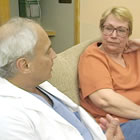 Findings in a report issued last week by the Blue Shield of California Foundation demonstrate that an informed patient is an empowered patient: one who feels more comfortable asking questions of one’s healthcare provider, and making decisions about one’s own healthcare.
Findings in a report issued last week by the Blue Shield of California Foundation demonstrate that an informed patient is an empowered patient: one who feels more comfortable asking questions of one’s healthcare provider, and making decisions about one’s own healthcare.
While this equation may seem obvious, the report puts numbers to the equation, marking the significant differences between the informed and uninformed patient. Most importantly, the patient population studied consisted of low income families with annual household incomes less than 200% of the federal poverty level, or about $46,000 for a family of four.
And here’s the surprise for those who may “write-off” this segment of patients as not being capable of “understanding” complex issues. According to the report, feeling informed about their health condition and confident in playing a role in their health care decisions was a stronger predictor of patients’ level of engagement than choice of health facility, level of education, income, gender, language spoken or race/ethnicity. Got it? Information and understanding trumped all these other issues.
The problem for low income patients, and I would expand that to ALL patients, is that the best way to be informed, according to 80% of the respondents in an earlier survey, was to have someone at a health care facility who “knows you pretty well,” but only 38% of respondents reported having such a point-person.
According to a press release from Blue Shield of California, some of the key findings of the study were:
- Nearly seven in 10 of those who feel very informed about their health also feel very confident in their ability to make healthcare decisions. Strong confidence falls to 44 percent among those who feel less than very well-informed;
- Among patients who feel informed about their health, 67 percent say they’re very comfortable asking questions of their provider. Among those who feel less informed, comfort asking questions drops by half, to 33 percent;
- Among patients who feel highly informed about their health, 61 percent say they always understand their providers’ advice and treatment plans. That declines to 34 percent of those who feel just “somewhat” informed and 18 percent of those who feel less informed about their health;
- Involvement in care is 19 points higher among patients who are very confident in their ability to make health decisions than among the less confident, 81 percent vs. 62 percent.
This empowerment, the ability to make shared decisions, is especially important for patients about to get an angioplasty or stent. Perhaps the Web can fill in some of the knowledge gaps. I know that we get scores of patients writing into our Patient Forum every month, asking the kinds of questions that they should be asking their physicians, but aren’t able to for one reason or another. Often we steer them to outside resources or articles on Angioplasty.Org, especially in our PatientCenter, which give them a better understanding of their situation and, we would like to think. help them manage their disease process more successfully.
Reading this study reminded me of the words of Adolph Bachman, the first coronary angioplasty patient, who appears in the historical video we just posted a couple days ago. When discussing why he agreed to be the first one to get an angioplasty, he said of Dr. Gruentzig:
“Everything was so clear. Even as a total layman, I understood his method. I understood what was going to go on and I knew there was no reason to worry. I was 100% convinced that it would be successful. But that was all because Dr. Gruentzig was so clear and because the method itself was so simple.”
Clarity, communications, empowering patients with information: these certainly are very important and critical goals for improving healthcare.





Excellent blog and article.
My sister is allergic to metal and the Doctor just said . ‘you eat with metal’ and will not discuss about a metal stent in her leg. Is there a plastic stent (if they go that route) that can be used? The Dr. will be sending her to a surgeon for the procedure. How do you go about getting a second opinion?
Most stents are made from an alloy, and most contain nickel, which is probably the metal your sister is allergic to. The Instructions for Use (IFU) for these stents all say that they are contraindicated in patients who are allergic to one or more of the components. On one hand, studies have been performed that show no significant adverse reactions to these stents from patients allergic to metal (the amount of metal is quite small). On the other hand, many patients have written into our Forum Topic on this subject, so something is happening. We urge you to read the comments on that topic, and to post your questions there.
My husband is 70 years old. He has been taking one nebolizer treatment once a day to open up his lungs, type 11 diabetes and had a triple bypass back in “1995” He recently had a heart cath that is showing one graft, completely closed and one artery, 60% closed. The heart dr. says he only wants to open up the artery that is 60% blocked and do nothing with the graft. I am wondering why he would not want to open up the graft that is completely blocked and only open the artery. Is there a dr. in Michigan that does non-invasive surgery to unblock a stent so my husband could have both done the same day? After the dr. who would be doing the surgery has an opening next Tuesday and I feel uneasy since the graft would be left alone. Do you feel he should wait and hopefully find a surgeon who will do both or go ahead with surgery? This will make the second heart cath lately. After the first one, he didn’t put in a stint because he wanted to wait until he could talk to other dr.’s. Please advise…Thank You